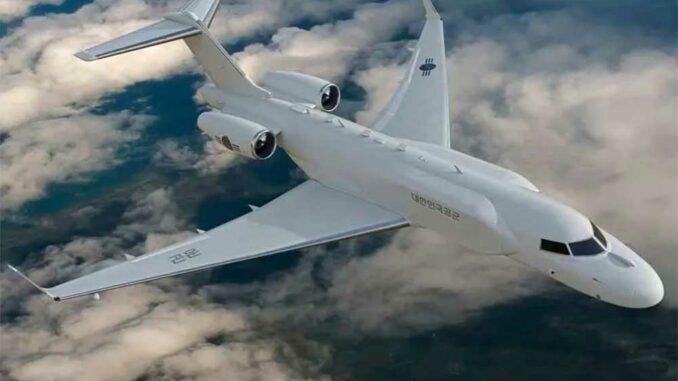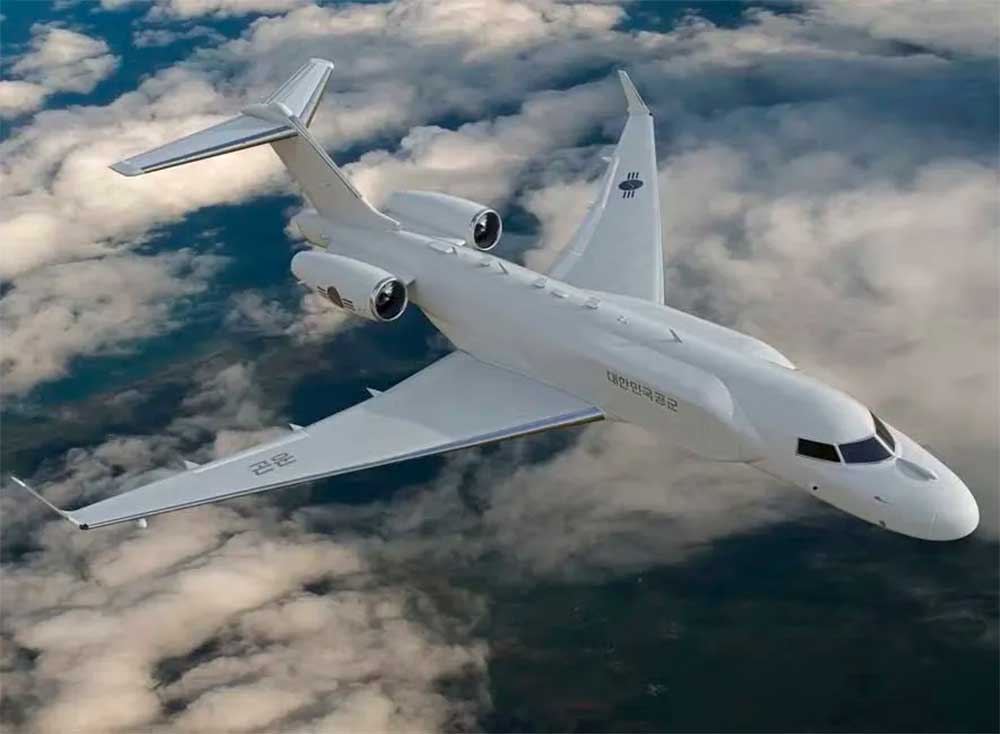
South Korea has opted for L3Harris’ Global 6500 equipped with EL/W-2085 radar for its AEW&C program, strengthening its air surveillance capabilities.
Summary
South Korea has selected the L3Harris-modified Global 6500, equipped with the Israeli EL/W-2085 radar, as its new airborne surveillance (AEW&C) aircraft as part of its AEW&C II program. The contract covers the purchase of four aircraft to be delivered by 2032 at a cost of approximately 3.1 trillion won (≈ $2.2 billion). The decision comes after a competition in which L3Harris beat Saab (GlobalEye) by scoring higher on operational adaptation, maintenance costs, and domestic industrial participation. This choice marks a strategic turning point in Korea’s ability to provide constant aerial surveillance in the face of regional threats.
The context: South Korea’s needs and constraints
For several years, South Korea has been seeking to strengthen its air detection and control capabilities, particularly in the face of growing threats from missiles, drones, and hostile air activities. Its mountainous terrain makes ground-based radars less effective in certain shadow areas, which is why airborne solutions are being used.
Currently, the South Korean Air Force has four Boeing E-7 (local version E-737) aircraft acquired as part of the Peace Eye program (delivered between 2011 and 2012) for approximately $1.6 billion. However, these aircraft have been affected by insufficient availability rates: reports dating back to 2019 mention frequent breakdowns, a 75% availability target that has not been met, and gaps in airborne radar coverage that compromise operational readiness.
The AEW&C II program, officially launched in 2020, therefore aims to acquire four new aircraft by 2032 in order to expand and diversify air coverage, correct deficiencies in the existing fleet, and strengthen ISTAR (Intelligence, Surveillance, Target Acquisition, Reconnaissance) capabilities.
Competitors included Saab (with its GlobalEye system, also based on the Global 6500) and Boeing (with an extended E-7 offering). However, Boeing appears to have been eliminated or marginalized earlier in the selection process.
The L3Harris choice: technical and strategic considerations
Selected platform and radar
L3Harris is offering a modified version of the Bombardier Global 6500, dubbed “Phoenix.” This business jet has been converted to accommodate the EL/W-2085 radar, developed by the Israeli firm IAI/ELTA, with an AESA (active electronically scanned array) architecture.
The configuration chosen is known as conformal, meaning that the antennas are integrated into the sides of the aircraft rather than mounted on a conventional dome. Front and rear antennas are added for 360° coverage.
The EL/W-2085 radar is dual-band, with GaN (gallium nitride) technology, which gives it better performance in terms of range, resolution, and energy efficiency.
In its documentation, L3Harris highlights that the Global 6500 is already well proven in both civilian and military environments, with relatively low costs per flight hour, which is an operational advantage.
Evaluation criteria and results
According to statements by the South Korean procurement agency (DAPA), the selection criteria included:
- operational suitability (ability to fulfill the required missions)
- contribution to local industry (technology transfer, domestic production)
- operating and maintenance costs
- contract terms and acquisition costs
L3Harris scored higher on the first three criteria, while Saab was more favorable on purchase costs and certain contract terms. In the end, the summary of the evaluations gave L3Harris the advantage.
A key aspect of the project is the participation of Korean industry: Korean Air is involved in modifying the aircraft (on the third and fourth units) and will provide maintenance within the country. The plan includes knowledge transfer, local integration, certification, and long-term support.
Cost, schedule, and deliveries
The program is estimated to cost 3.0975 trillion won, or approximately $2.2 billion for the four aircraft. Some South Korean media outlets are reporting a figure of 3.87 trillion won (≈ $2.82 billion), but this may include additional margins or phases.
Delivery is scheduled for 2032. The first two units will likely be modified overseas, while the next two will be converted and tested in South Korea. ([Flight Global][8])
The Phoenix system is also based on a modular open architecture (MOSA) that allows for future upgrades to the radar, avionics, or software to adapt to new threats.

Impacts, consequences, and challenges
From a strategic and operational perspective
The addition of four Phoenix aircraft enables continuous surveillance and enhanced radar coverage, particularly in sensitive areas (Yellow Sea, East Sea, northern border). This improves the deterrent posture against missiles, drones, and air incursions from North Korea or neighboring countries.
Diversifying the fleet (E-7 + Phoenix) reduces the risk associated with dependence on a single family of aircraft and offers a more resilient architecture.
The conformal radar architecture offers an aerodynamic advantage: less drag, better performance at high altitudes, while ensuring global coverage. This makes the system more effective for long-duration missions without refueling.
For the domestic industry and technology transfers
The inclusion of Korean Air and local players in integration, testing, maintenance, and certification creates local industrial value. Technology transfer will enable skills development in advanced aeronautical and radar systems.
In the long term, this could lead to greater operational autonomy, less dependence on foreign suppliers, and support for the South Korean defense sector.
Potential constraints and challenges
Modifying a civilian jet into a military radar platform is complex: the integration of radar, cooling, power supply, consoles, data links, and certification must be carefully managed. The program must prove operational reliability and compatibility in military environments.
The schedule is demanding: delivering four aircraft by 2032 involves design, testing, certification, and pacing. Delays could impact the desired coverage.
In addition, maintenance, modernization, and support costs over time will need to be controlled to ensure that the investment remains sustainable.
Impact on Boeing
Korea’s decision is a setback for Boeing, which had been a candidate with its E-7 Wedgetail. The company could lose an important market in the region.
Comparative analysis: GlobalEye vs. Phoenix
Saab offered the GlobalEye, an AEW&C system also based on the Global 6000/6500, with its Erieye Extended Range (ER) radar. Saab’s offer was considered more favorable in terms of acquisition cost and certain contractual conditions.
However, the competition gave L3Harris the advantage thanks to its high score on industrial criteria, maintenance costs, and operational suitability. In other words, even though Saab’s bid was competitive, it did not offer the same level of local support or long-term performance guarantees.
It is interesting to note that the two bids were technically competitive: evaluations indicate that there was no significant difference in radar performance in the basic criteria according to DAPA.
This comparison shows that, in this type of project, the national industrial ecosystem and operating costs become as important levers as pure performance.
Perspective and significance
This South Korean contract is the first confirmed export of L3Harris’ Phoenix AEW&C aircraft. The initiative marks a rise in popularity of converted bizjet platforms for military ISR (Intelligence, Surveillance, Reconnaissance) missions.
This selection could inspire other countries evaluating options for their airborne radar capabilities, showing that more compact, flexible jets with lower operating costs can compete with more traditional configurations.
For South Korea, this is a clear indication that the future of its aerial surveillance is not limited to large conventional platforms, but is moving toward more modular, integrated, and resilient solutions.
War Wings Daily is an independant magazine.